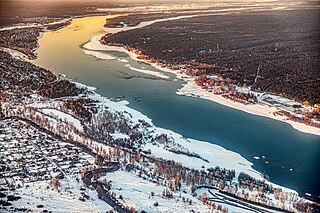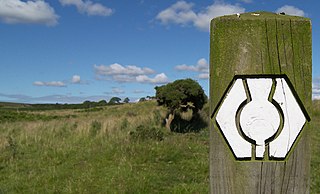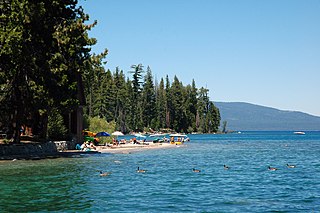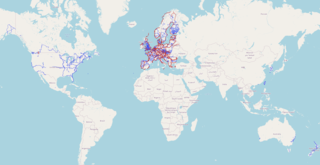This article needs additional citations for verification .(August 2014) |
Here is a list of the longest hiking trails in the world from longest to shortest.
This article needs additional citations for verification .(August 2014) |
Here is a list of the longest hiking trails in the world from longest to shortest.

The system of transport in Cambodia, rudimentary at the best of times, was severely damaged in the chaos that engulfed the nation in the latter half of the 20th century. The country's weak transport infrastructure hindered emergency relief efforts, exacerbating the logistical issues of procurement of supplies in general and their distribution. Cambodia received Soviet technical assistance and equipment to support the maintenance of the transportation network.

The Ob is a major river in Russia. It is in western Siberia, and with its tributary the Irtysh forms the world's seventh-longest river system, at 5,410 kilometres (3,360 mi). The Ob forms at the confluence of the Biya and Katun which have their origins in the Altai Mountains. It is the westernmost of the three great Siberian rivers that flow into the Arctic Ocean. Its flow is north-westward, then northward.

Hiking is a long, vigorous walk, usually on trails or footpaths in the countryside. Walking for pleasure developed in Europe during the eighteenth century. Religious pilgrimages have existed much longer but they involve walking long distances for a spiritual purpose associated with specific religions.
National Trails are long distance footpaths and bridleways in England and Wales. They are administered by Natural England, an agency of the UK government, and Natural Resources Wales, a Welsh government-sponsored body.
National Millennium Trails are 17 short- and long-distance trails selected from 58 nominees as visionary trails that reflect defining aspects of America's history and culture. The trails were chosen on June 26, 1999, by the White House Millennium Council and announced by U.S. Transportation Secretary Rodney Slater at the second international Trails and Greenways Conference in Pittsburgh, PA.

A medium-range ballistic missile (MRBM) is a type of ballistic missile with medium range, this last classification depending on the standards of certain organizations. Within the U.S. Department of Defense, a medium-range missile is defined by having a maximum range of between 1,000 and 3,000 kilometres. In modern terminology, MRBMs are part of the wider grouping of theatre ballistic missiles, which includes any ballistic missile with a range of less than 3,500 kilometres (2,200 mi). Roughly speaking, MRBM covers the ranges over SRBM (tactical) and under IRBM.

An ultramarathon, also called ultra distance or ultra running, is a footrace longer than the traditional marathon length of 42.195 kilometres. Various distances, surfaces, and formats are raced competitively, from the shortest common ultramarathon of 31 miles (50 km) and up to 3100 miles. World Championships are held by the International Association of Ultrarunners (IAU) for 50 km, 100 km, 24 hours, and ultra trail running. The Global Organization of Multi-Day Ultramarathoners (GOMU) holds World Championships for 48 hours and 6 days. World Records are ratified and recognized by World Athletics, the IAU, and by GOMU.

EuroVelo is a network of 17 long-distance cycling routes criss-crossing Europe, in various stages of completion. When completed, the EuroVelo network's total length will be almost 90,000 km (56,000 mi). As of November 2022 more than 56,000 km (35,000 mi) were in place. EuroVelo is a project of the European Cyclists' Federation (ECF).
A theatre ballistic missile (TBM) is any ballistic missile with a range less than 3,500 kilometres (2,200 mi), used against targets "in-theatre". Its range is thus between that of tactical and intermediate-range ballistic missiles. The term is a relatively new one, encompassing the former categories of short-range ballistic missile and medium-range ballistic missile. Examples of this type of in-theatre missile are the Soviet RT-15, TR-1 Temp and American PGM-19 Jupiter missile, both from the 1960s.

Scotland's Great Trails are long-distance "people-powered" trails in Scotland, analogous to the National Trails of England and Wales or the Grande Randonnée paths of France. The designated routes are primarily intended for walkers, but may have sections suitable for cyclists and horse-riders; one of the trails, the Great Glen Canoe Trail, is designed for canoeists and kayakers. The trails range in length from 40 km (25 mi) to 340 km (210 mi), and are intended to be covered over several days, either as a combination of day trips or as an end-to-end trip.
In aviation, the flight length or flight distance refers to the distance of a flight. Aircraft do not necessarily follow the great-circle distance, but may opt for a longer route due to weather, traffic, to utilise a jet stream, or to refuel.
John Merrill, from London, England, is a leading marathon walker. He attended Westbourne School in Sheffield, Grosvenor House School in Harrogate, and Wennington School in Wetherby, Yorkshire, between 1955 and 1961. He is active in two areas: firstly undertaking extremely long walks, and secondly publishing books about walking, dealing with both his experiences and describing routes for readers to follow. In January 2003, he was made an Honorary Master of Derby University, for his walking and writing. He also lectures extensively about walking. By July 2020 he had walked more than 227,500 miles and worn out 149 pairs of boots, over 1,500 pairs of socks and 49 rucksacks. He is a keen skier both downhill and cross country, a cyclist and qualified Qigong teacher.

A long-distance trail is a longer recreational trail mainly through rural areas used for hiking, backpacking, cycling, horse riding or cross-country skiing. They exist on all continents except Antarctica.

The Moray Coastal Trail is a long-distance path in North-East Scotland that runs along the coastline of the Moray council area. The route, which is 72 km (45 mi) long, runs between Forres and Cullen. It is designated as one of Scotland's Great Trails by NatureScot, and connects with two further Great Trails: the Speyside Way at Spey Bay, and the Dava Way at Forres. The Moray Coast Trail can be combined with sections of these two routes to form a 153 km (95 mi) circular route known as the Moray Way, and also forms part of the North Sea Trail. The trail is primarily intended for walkers, but many sections are also suitable for cycling and horseriding. An alternative route for cycling, the Moray Coast Ride, shares some sections of path with the Moray Coast Trail, and forms part of the National Cycle Network's Route 1. About 23,000 people use the path every year, of whom about 1,000 complete the entire route.

Ed Z'berg Sugar Pine Point State Park is a state park in California in the United States. It occupies nearly two miles of the western shore of Lake Tahoe and a total of about 1,000 hectares of forested mountains in El Dorado County. Originally called Sugar Pine Point State Park, its name was changed in 2003 to honor Edwin L. Z'berg, a California state assemblyman who specialized in environmental legislation and worked to develop state parks and other natural areas.

Long-distance cycling routes are designated cycling routes in various countries around the world for bicycle tourism. These routes include anything from longer rail trails, to national cycling route networks like the Dutch LF-routes, the French Veloroute or the routes of the British National Cycle Network, to the multi-state routes of the United States Bicycle Route System, to the multi-country routes of the EuroVelo network in Europe, the longest of which is over 6,800 km (4,200 mi) in length.
The definition of ultra-distance cycling is far more vague than in ultra running or in ultra-triathlon. Any bike race or ride longer than a century ride, which is 100 miles (160 km), is sometimes considered to be ultra-distance cycling. However, such events are relatively common, so using a longer distance to define the category is more useful, such as any race or ride that is longer than 200 kilometres (120 mi), 300 kilometres (190 mi) or even a double century, 200 miles (320 km).